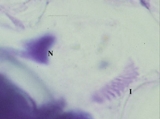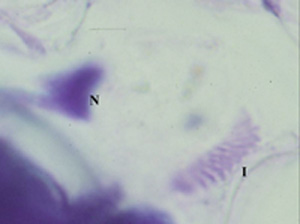
Clover yellow mosaic virus
Encyclopedia
Clover yellow mosaic virus (ClYMV) is a plant pathogenic virus in the genus Potexvirus
and the virus family Alphaflexiviridae
. Its flexous rod-shaped particles measure about 539 nm in length.
Like other members of the Potexvirus genus, ClYMV is a monopartite strand of positive-sense, single-stranded RNA surrounded by a capsid made for a single viral encoded protein. The genome has been completely sequenced and is 7015 nucleotides long. No insect vector is known. This virus is transmitted by mechanical inoculation, sometime by seeds and by dodder (Cuscuta campestris).
Potexviruses make banned inclusions made up of layers of parallel virus particles. These inclusions are can be seen in the light microscope in leaf strips of infected plant tissue stained with Azure A or Orange-Green stains. For many potexviruses these inclusions can be disrupted during the staining procedures. The banded inclusions of ClYMV (Fig.1) however, remain stable and therefore can be diagnostic. Antiserum is available for this virus and, as mentioned above, so is sequence data.

Figure 1. Banned inclusions body (I) of Clover yellow mosaic virus in Vicia faba cells, stained with Azure A.(N = nucleus)
(Vigna sinensis). The one that systemically infected cowpea became known first as pea wilt virus and then as White clover mosaic virus
(WClMV). The one that was transmitted by dodder became known as pea mottle virus and eventually Clover yellow mosaic virus.
ClYMV is know known to infect several other species of clover, peas (Pisum sativum), faba beans (Vicia faba
), green beans (Phaseolus vulgaris),cucumbers (Cucumis sativus) and snapdragons (Antirrhinum majus
). ClYMV can infect cowpea but it does not spread as fast as WClMV or at all beyond the inoculated leaves.(7)
Until the year 2004, ClYMV was found only in north western regions of the United States and south western regions of Canada. In 2004 it was reported in the eastern United States (Florida) for what is believed to be the first time. It was found in a new host, the ornamental plant, Verbena
canadensis variety ‘homestead purple’. In 2005, it was reported in England in the another verbena variety. Verbena varieties are propagated by cuttings.
Potexvirus
Potexvirus is a genus of plant pathogenic viruses, belonging to the family Alphaflexiviridae and the order Tymovirales. Transmission occurs mechanically, with viruses in this genus causing mosaic and ringspot symptoms....
and the virus family Alphaflexiviridae
Alphaflexiviridae
Alphaflexiviridae are single-stranded positive sense RNA plant viruses, belonging to the order Tymovirales and thus to group IV of the Baltimore classification of viruses.The Alphaflexiviridae family include the following genera:...
. Its flexous rod-shaped particles measure about 539 nm in length.
Like other members of the Potexvirus genus, ClYMV is a monopartite strand of positive-sense, single-stranded RNA surrounded by a capsid made for a single viral encoded protein. The genome has been completely sequenced and is 7015 nucleotides long. No insect vector is known. This virus is transmitted by mechanical inoculation, sometime by seeds and by dodder (Cuscuta campestris).
Potexviruses make banned inclusions made up of layers of parallel virus particles. These inclusions are can be seen in the light microscope in leaf strips of infected plant tissue stained with Azure A or Orange-Green stains. For many potexviruses these inclusions can be disrupted during the staining procedures. The banded inclusions of ClYMV (Fig.1) however, remain stable and therefore can be diagnostic. Antiserum is available for this virus and, as mentioned above, so is sequence data.

Figure 1. Banned inclusions body (I) of Clover yellow mosaic virus in Vicia faba cells, stained with Azure A.(N = nucleus)
Host Range and Geographic Distribution
The major host of ClYMV is clover (Trifolium spp). It was first reported in white clover (Trifolium repens ) as early as 1939. However in 1942 the virus in white clover, then called Trifolium virus 1 or white-clover mosiac was found to be two different viruses when one proved to be transmitted by dodder and did not infect cowpeaCowpea
The Cowpea is one of several species of the widely cultivated genus Vigna. Four cultivated subspecies are recognised:*Vigna unguiculata subsp. cylindrica Catjang...
(Vigna sinensis). The one that systemically infected cowpea became known first as pea wilt virus and then as White clover mosaic virus
White clover mosaic virus
White clover mosaic virus is a plant pathogenic virus in the genus Potexvirus and the family Flexiviridae. WClMV is a filamentous, flexuous rod, 480 nm in length and 13 nm wide....
(WClMV). The one that was transmitted by dodder became known as pea mottle virus and eventually Clover yellow mosaic virus.
ClYMV is know known to infect several other species of clover, peas (Pisum sativum), faba beans (Vicia faba
Vicia faba
This article refers to the Broad Bean plant. For Broadbean the company, see Broadbean, Inc.Vicia faba, the Broad Bean, Fava Bean, Field Bean, Bell Bean or Tic Bean, is a species of bean native to north Africa and southwest Asia, and extensively cultivated elsewhere. A variety is provisionally...
), green beans (Phaseolus vulgaris),cucumbers (Cucumis sativus) and snapdragons (Antirrhinum majus
Antirrhinum majus
Antirrhinum majus is a species of plants belonging to the genus Antirrhinum...
). ClYMV can infect cowpea but it does not spread as fast as WClMV or at all beyond the inoculated leaves.(7)
Until the year 2004, ClYMV was found only in north western regions of the United States and south western regions of Canada. In 2004 it was reported in the eastern United States (Florida) for what is believed to be the first time. It was found in a new host, the ornamental plant, Verbena
Verbena
Verbena , verbenas or vervains, is a genus in the family Verbenaceae. It contains about 250 species of annual and perennial herbaceous or semi-woody flowering plants. The majority of the species are native to the New World from Canada south to southern Chile, but some are also native in the Old...
canadensis variety ‘homestead purple’. In 2005, it was reported in England in the another verbena variety. Verbena varieties are propagated by cuttings.

